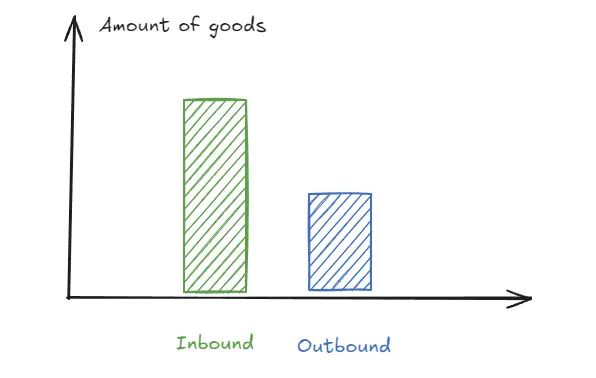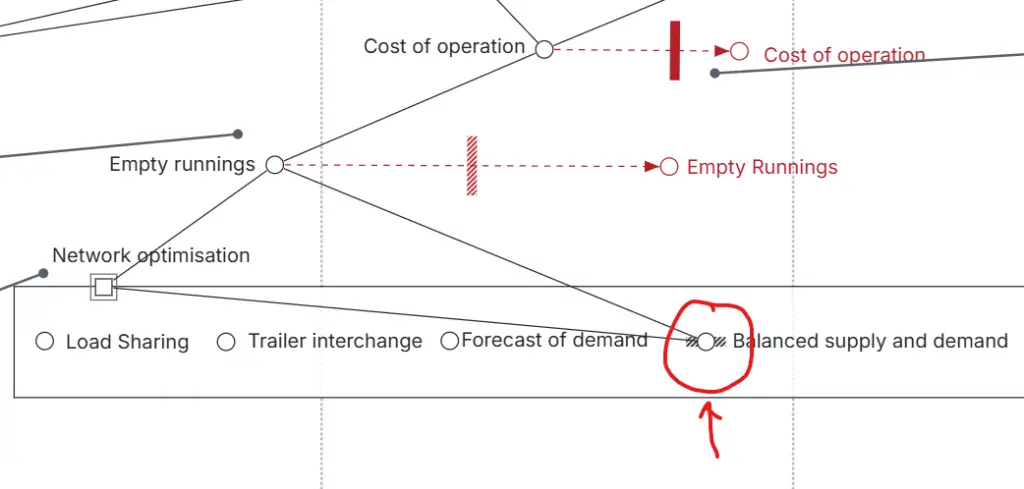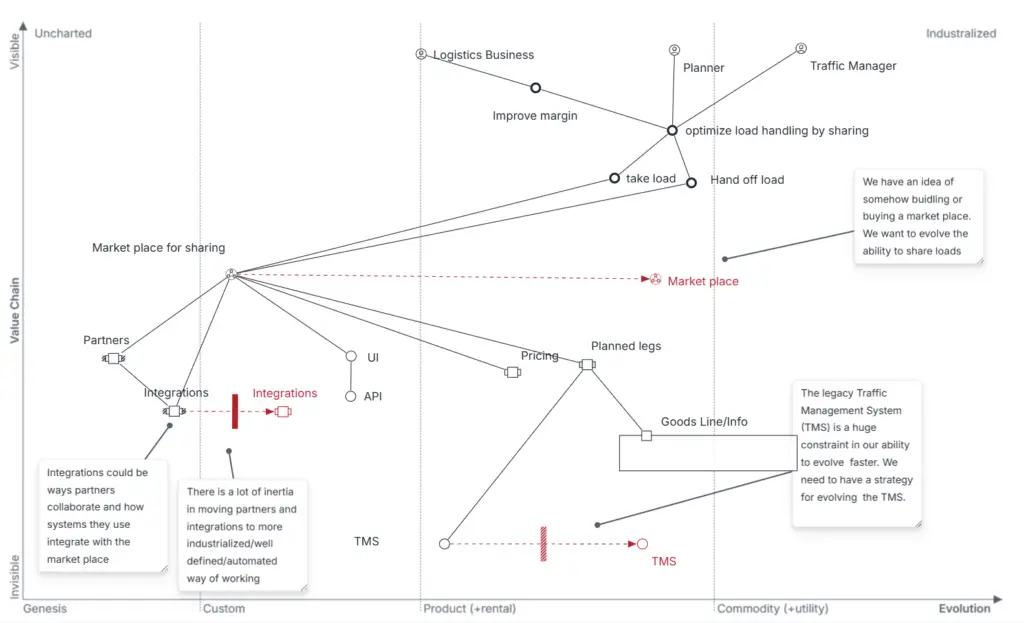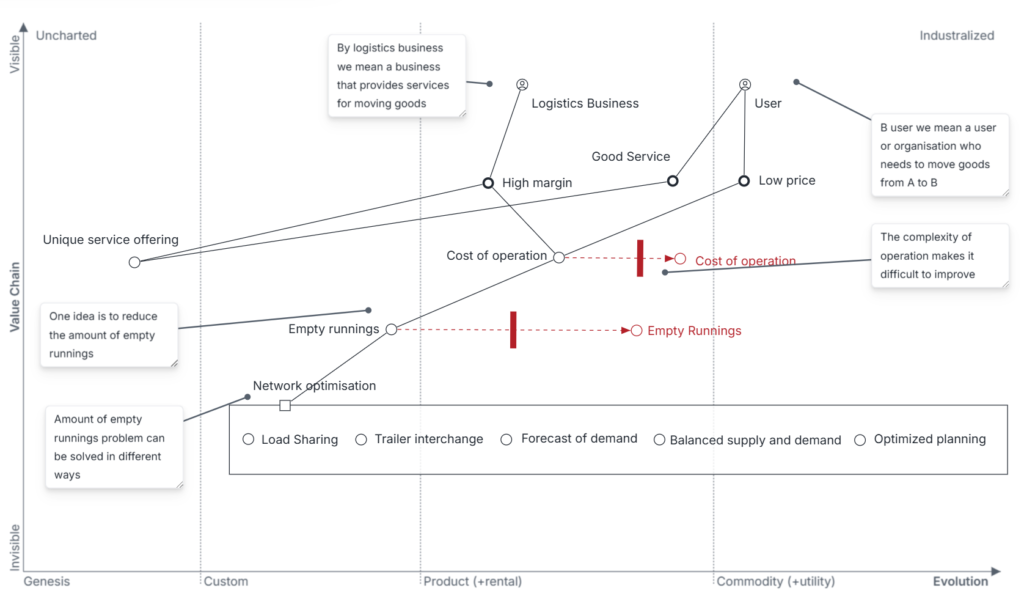Introduction
In this post I will try to describe how we in a product team tried to use wardley mapping to visualize our current situation. We had several options to chose from in the form of different Proof of Concepts (POC’s) that the team was given to analyze. In short the team needed to find the best next action to take.
The goal of the post is to examplify general questions one might ask one self when deciding what to do and not to do in a strategic context. Our decisions and actions should be coherent and be rootet in a higher strategy and purpose. But how do we translate between generic, abstract theory and concrete examples in specific contexts?
What is Wardley Mapping?
I will assume that you allready know this. Rather than duplicating numerous introductions to the subject I will dedicate the time here to dive into more concrete examples.
For a quick reference check this 1:30 minutes video by Ben Mosior here
or a 9 minute video by the inventor of Wardley maps Simon Wardley here
For another article explaining the basics please take a look here.
What is a Strategy?
In the following I will use the strategy definition defined by Richard Rumelt in “Good Strategy, Bad Strategy”.
He divides a kernel strategy in to four essentiel components:
- Challenge
- Diagnosis
- Guiding Policies
- Coherent Actions
The Challenge
In relation to warldey mapping the idea of purpose is a kind of challenge. But another way to look at challenge comes from theories of constraints. If we can identify the essential or most important constraint in our system or value chain, then we can say that we have identified a challenge or the challenge we want to address. Tristan Slominski has an excelent tutorial where he explains how to map constraints in a wardley map. He also epxlains different kinds of constraints like constraints in User, User need or component in a wardley map.
Diagnosis
Diagnosis sounds very much like being at the doctor. And this is actually a usefull analogy. Often when going to the doctor you have a very concrete problem or challenge. The doctor will ask you questions, examine you and try to make a diagnosis. If the doctor just resort to general actions to take like drinking more water, eating more healthy or just ordinate pain killlers you might get disappointet. While these advices might be of general value you don’t feel that the doctor has taken you serious or actually determined what your exact problem is. What I am trying to communicate here is that you might actaully suffer from a more rare syndrom that can not just be cured by drinking more water. The same goes for business strategies. Often we just treat our situation as generic and thus we try to mimic what every one else does. We should instead start examining our own situation and come up with a diagnosis specific to the challenge we are facing.
In relation to wardley mapping concepts as situational awareness and drawing a map of our situation and context is a form of diagnosis.
Guiding Policies
Guding policies are needed to help us make decisions. Having identified the challenge we want to do something about and having done a proper diagnosis, we need to move toward something concrete in the form of coherent actions.
Guiding policies tries to constrain our options in order not to get lost in endeless analysis and opportunities. In relation to warldey mapping
concepts as doctrine, climatic patterns and game plays spring to mind as examples of guiding policies.
Coherent Actions
Coherent Actions are concrete actions that are, well yes, coherent. Well that sounded like a circular explanation. What we want to emphasis here is that actions are something tangible as opposted to abstract or generic. By using the word ‘coherent’ we want to emphasise that the actions should work together and point in the same direction. In chess we could say that moving the pieces are actions, and if the movements support each other, they are coherent. We don’t want actions that are uncoherent.
Actions can sometimes become uncoherent if we make “strategy by comity”.
“Strategy by comity” occurs when decisions are made based on consensus or compromise, often to appease multiple stakeholders with conflicting interests.
So the Strategy and coherent actions are in danger of becoming fragmented rather than aligned. The Guiding policies should help os creating coherent actions and avoid fragmented actions.
How Strategy by Comity Leads to Incoherent Actions
- Conflicting Goals: When multiple stakeholders have differing priorities, the resulting strategy may attempt to address all of them, even if they are contradictory.
- Example: An organization might simultaneously pursue cost-cutting (efficiency) and extensive market expansion (growth), leading to resource conflicts.
- Scattered Efforts: Without a clear focus, resources and efforts are spread thin, making it hard to achieve any meaningful progress on a single goal.
- Lack of Synergy: Actions taken under strategy by comity often lack the interdependence and reinforcement necessary for a coherent strategy.
- Reactionary Decisions: Instead of proactive, aligned actions, decisions are made in response to external pressures or to satisfy internal factions, undermining long-term strategic goals.
Mitigating Incoherence in Strategy by Comity
How do we then avoid the mistakes just mentioned?
- Establish a clear guiding policy to ensure all actions align with the same strategic objective.
- Use Rumelt’s kernel of strategy to identify trade-offs and prioritize.
- Ensure leadership enforces discipline in decision-making to avoid the temptation of appeasing every stakeholder at the expense of coherence.
Wardley maps to the rescue
Fig 1. A Logistics Value Chain
Introduction to example 1 “A Logistics value chain”
In a warldey map we allways start with the users and user needs. (This is one of the Wardley docrines)

Fig. 2. Some of the wardley doctrines. Notice ‘Know Your users…’, and ‘Focus on user needs’.
In this map the users are the ‘logistics business’ and ‘User’ which represent users or organisations who need get good s moved from A to B.
The User needs good service at a low price.
The Logistics Business wants high margin.
Both the needs of the Logistics Business and the User are dependent on the components ‘Unique Service Offering’ and ‘Cost of operation’
What should the business do ?
So the big question now is what is the next best thing for the business to do?
Should we develop our unique service offering, so we can demand higher prices?
Or should we try to reduce costs of operation in a competitive market ?
We might not have the resources to pursue both stategies or tactics!
For the sake of this example we will assume that we focus on reducing the cost of operation.
We can visualise this on the wardley map by drawing the cost of operation component in an evolved state like we have done in figure 1.
Again there are many ways to reduce cost of operation. But for this example we will focus on the problem of Empty runnings.
What are empty runnings in the logistics domain?

Fig 3. Inbound and outbound flow of goods for a region.
We can see in this case that there are more inbound goods than outbound goods. So some of the trailers moving goods into the region has no goods to pick up and move out of the region.
We say that the region has an inbalance in flow of goods.

Fig 4. Inbalance in inbound and outbound flow of goods.
How does the logistics company solve this problem?
In the wardley map the Emty runnings are depicted as beeing dependent on ‘network optimisation’. Network optimisation are depicted as a socalled pipeline. Wardley mapping is an emergings practice even if it was invented 15 years ago. Here we use the pipeline notation to illustrate different alternatives for solving the same problem. So its debatable why its then called a pipeline. But this is one common use of the pipeline notation. Lets look at the different options.
We can say that the imperfect balance is a constraint in the system. We could theoretically remove the constraint if we could make sure that regions allways were balanced. In Our example a Logistics company could theoretically achieve this by focusing on getting more customers that needed outbound transportation. In the wardley map we could mark the component ‘Balanced supply and Demand’ as being a constraint in the system. If We could make all region balanced we could say that we have removed the constraint. Empty runnings would disappear if we had perfect balance.

Fig 5. Marking a component as being a constraint in the system.
In wardley maps we mark things as constraints by using a bar with striped fill pattern. A constraint can be depicted on the component circle itself or as a bar that signals a constraint that prevents evolution.
In strategy we have two options when it comes to constraints. Removing the constraint or exploting the constraint. Rather than removing the constraint we could exploit the constraint. We can use the constraint to our advantage rather than removing it. How so ?
We could introduce the concept of loadsharing. We could create a market place where logistics operators could buy and sell orders that they don’t want to fullfill themselves because it would lead to an empty running and therefore would lead to low margin or even negative margin.
Another option is to introduce ‘trailer interchange’. Instead of buying adn selling movement orders we can rent out or rent (in) trailers if we have to many or to few in a region.
Another concept closely related to imbalance and empty running is the concept of ‘rebalancing‘. Rebalancing is the act of moving trailers/ equipment to the regions where they are needed.
So where are the trailers/equipment needed ? This question can be answared if we can predict or forecast demand for transportation. If there were no imbalances there would be no need for forecast of demand.
In summary we have explained the differnt alternatives shown in the Network Optimisation pipeline:
- Load Sharing
- Trailer Interchange
- Forecast of Demand
- Balanced supply and demand
We can analyse each of these alternatives to determine what is our best next action. These are candidates for further blog posts.

Fig. 6. Warldey map focuced on the Load Sharing alternative.
Here is an example of a focused Wardley map. We cannot add everything to the wardley map since it would make it to complex. Therefore we link wardley maps to maps with more detail.
A Warldey map is used to tell a story. It doesn’t have to be perfect. But if it can help you communicate your thinking alot has been achieved.
“Our biggest problem in the software industry is not how we configure Kubernetes but how we think well collectively”
Diane Montalion
Summary
- We explained Rumelts Strategy Kernel
- We emphasised the importance of a coherent strategy and the downsides of doing strategy by comity.
- We explained concepts in wardley mapping with a practical example
- Wardley Doctrines
- User
- User needs
- components
- dependencies
- evolution and movement of components
- visualising alternatives as a pipeline
- visualising constraints in a Wardley map
- The difference between removing and exploiting constraints
- We connected wardley mapping concepts to the problem domain of logistics.
Resources
- Simon Warldey book
- Eric Shön examples of warldey maps
- Ben Moisor Learn Wardley mapping
- Wardley mapping for business
- Richard Rumelt Good Strategy Bad strategy.
- Diane Montalion ‘Learning Systems Thinking’
- Tristan Slominski MapKeep
- Joaquín Peña Fernández Blog
- David Anderson The Value Flywheel Effect








